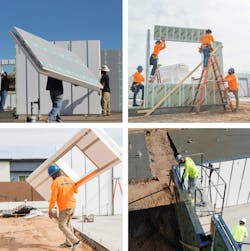Arizona builder SoDella Construction questioned the way it was constructing houses. “Can we build smarter and better and with fewer resources? Can we build off-site and be more predictable?” asked Mike Mancini, president and founder.
SoDella’s search for a more innovative and reliable construction process quickly ran into a common industry problem, however: “As the trade base got busier and busier, it was less likely to change,” Mancini said.
During a recent LinkedIn event hosted by the Housing Innovation Alliance and moderated by its president, Dennis Steigerwalt, Mancini discussed how his company overcame that challenge by adopting HercuTech’s panel wall system, HercuWall.
HercuTech’s CEO, Jason Rhees, understood Mancini’s dilemma: “Any time you introduce a new product to a market, change is scary. And we don’t operate in a space that’s quick to adopt innovation,” he said.
But, Rhees added, the industry now realizes innovation is no longer an option. “Investors, developers, and the trades know they have to change their business model to grow.”
HercuTech's approach to panelized home construction
Made of concrete, steel, and expanded polystyrene (EPS) foam, HercuWall panels replace about 60 percent of the wood in a traditional house. Delivering R31 insulation, they reduce energy costs by about 40 percent.
HercuTech says its panel is three times stronger than a 2x4 wood stud but light enough for one person to carry. And it eliminates about two-thirds of framing labor. With HercuWall, builders can construct up to five stories, with walls up to 12 feet high.
The process begins by converting an architectural plan into a HercuWall system. HercuTech precision-builds the panels at its 60,000-square-foot manufacturing facility in Tempe, Arizona, where the company can produce over 6 million square feet of panels each year. HercuTech delivers the weather-resistant panels, each with its own identifying number, to a site ready to assemble and in the order of assembly.
“Our wall system eliminates costly, time-consuming steps. It replaces the guesswork of stick construction with planned precision,” Rhees said.
Rhees added that HercuTech’s simplified, predictable process has special appeal for production developers and builders with large, repeatable construction projects, like hotels, warehouses, schools, and build-to-rent communities.
After training its teams to install HercuWall, SoDella gained a workforce advantage, Mancini said. “It’s yielded a more secure labor base that sticks with us.” And an improved product: “We can produce a building less expensively and better, with less labor.”
Panelized wall system speeds home construction
When it used HercuWall, Southwest developer Paragon Development Group completed a project two months faster than it would have with stick construction.
Critically, HercuTech doesn’t simply supply a product. Its HercuFit program provides the training and tools that developers, builders, general contractors, and installers all need to successfully integrate the panels into their homes.
At the LinkedIn event, HercuTech leaders also touted their company’s sustainability, claiming it recycles about 98 percent of the waste associated with its product. “The only waste in our facility is a little from the weather-resistant barrier and our lunch waste,” said HercuTech COO Ken Ritzman.
Compared to an insulating concrete form (ICF) system that requires about 30 yards of concrete for a 2,000-square-foot home, Rhees said a HercuWall home of the same size needs just seven to nine yards of concrete. “There’s much less volume of concrete used to get the same strength,” he said.
RELATED: Architect Pushes the Design Limits of Modular Housing
While HercuWall reduces both a reliance on wood and a vulnerability to volatile lumber prices, the product does include a significant amount of metal. Ritzman said the company sidesteps potential supply chain issues by buying directly from steel mills and EPS suppliers—and, notably, by asking its customers for a 40 percent advance payment.
“That’s been successful for us and our customers,” Ritzman said of the upfront payment. “When we supply a product without any breaks in the supply chain process, timely completion of a project saves our customers money.”
In the past couple of years, HercuTech has completed over 300 units, and it currently has 6,000 units in design.
Speaking after the event, Steigerwalt said he believes the homebuilding industry needs many different innovations. “HercuTech is one solution in the technology solution mix,” he said.
“There’s a need for more building systems like this that increase productivity, reduce waste, and achieve high performance metrics,” Steigerwalt said. “HercuTech isn’t just pumping product into the market. It’s engaging an ecosystem, training stakeholders, and taking clients on a journey.”

